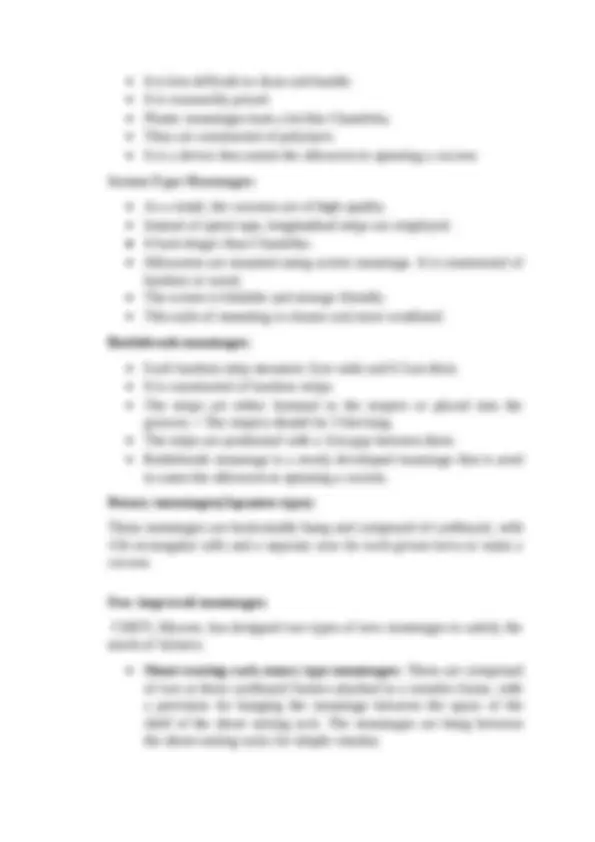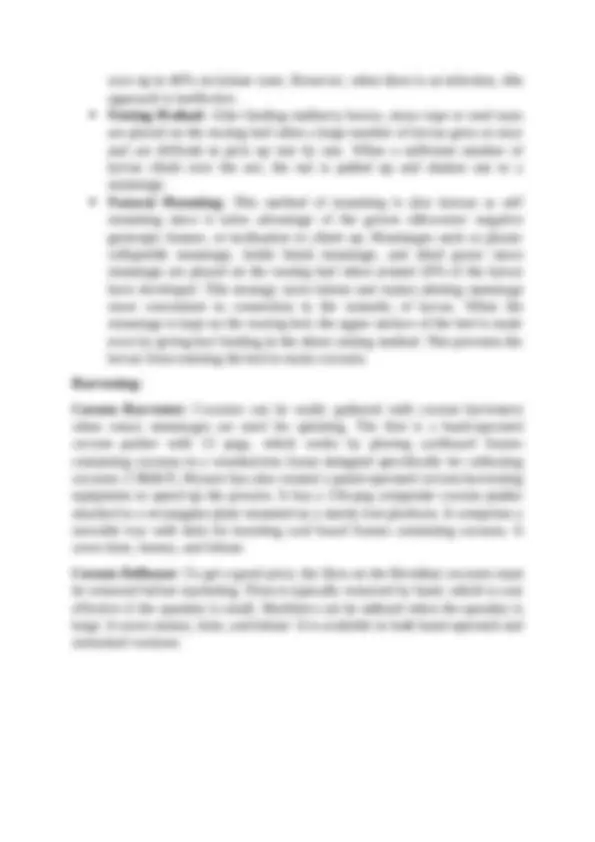





Study with the several resources on Docsity

Earn points by helping other students or get them with a premium plan


Prepare for your exams
Study with the several resources on Docsity

Earn points to download
Earn points by helping other students or get them with a premium plan
Community
Ask the community for help and clear up your study doubts
Discover the best universities in your country according to Docsity users
Free resources
Download our free guides on studying techniques, anxiety management strategies, and thesis advice from Docsity tutors
The different methods of mounting and harvesting used in sericulture have been presented in this.
Typology: Study notes
1 / 5

This page cannot be seen from the preview
Don't miss anything!




Mounting and harvesting Transferring adult larvae to a suitable frame for mounting gives worms a good anchor to build cocoons. At the end of the V stage, on the sixth or seventh day, there is a decrease in the amount of leaf that the larva consumes. The larva starts to crawl in the bed with its head elevated after releasing moist faeces, shrinking in size and turning translucent. These indicate the presence of spinning larvae. After observing those symptoms, the feeding amount should be decreased and the aeration level raised. In order to produce cocoons of high grade. Choosing the right mountages and using them correctly are crucial during cocoon spinning. Mountages refer to the frame utilised by worms to spin their cocoons. The spinning larvae are manually picked up and put on the mountages as they emerge from the rearing bed. Shaking the branches and gathering the larvae en masse makes it simple to separate the worms when they have all reached maturity and are prepared to spin. The spinning larvae are put on mountages made of bamboo or another material. 24°C temperature, 60-65% relative humidity, and sufficient aeration are required for spinning. Incorrect mounting technique and carelessness when mounting mature worms might be caused by defective cocoons. Because of the mounting and spinning requirements, this has an impact on reeling activity and ultimately leads to the manufacture of silk of poor quality. The ideal conditions for spinning a high- quality cocoon are 24 to 26 °C, a humidity of 60 to 70 %, and a current air speed of 0.5 to 1 m/s. As soon as the silk filament comes into touch with air, it begins to dry. Mountages The goal of using mountage is to offer an angular homogeneous space for silkworms, making cocoon development easier. A decent mountage should include the following features:
- Vertical fixed mountages: The mountages are held vertically for 6 to 8 hours. These are turned up and down a few times. There are eight cardboard frames in rotating mountages, each with 156 cells, mounted on a 1.8 x 1.2 m bamboo mat. On this cardboard, approximately 1100 to 1200 worms are mounted. Mounting and harvesting are simple in this case. Cocoon montages command higher prices during marketing than bamboo or plastic montages. Plastic rotary mountages: Polypropylene material is used to make these plastic rotational mountage frames, which are dyed in an injection mould. These are hung between two shoot-raising racks or on an iron disassembly-style support. Mounting hall: Farmers typically place mountages in the late age rearing home and verandah. When the rearings are continuous, a separate mounting hall is built. Management of mounting: Mounting is a time-consuming and labor-intensive task in silkworm cultivation. Picking up spinning worms, shoot shaking (Jobarai), and self-mounting methods are the most prevalent mounting methods. The self-mounting method involves putting plastic collapsible mountages on the rearing bed. When the worms begin to ripen, foldable plastic mountages are placed on the rearing bed, allowing the ripened worms to crawl onto the mountages and spin the cocoons. When 30% of the worms reach maturity, all of the worms are scooped up and left on the mountages to spin cocoons. The pick-up and mounting procedure have been determined to be optimal. Mounting Methods: The different types of mounting methods are as follows: Pick up Method: This is a process in which appropriately matured larvae are picked up by hand and placed on a mountage one by one. This approach allows silkworms to be mounted at the appropriate time and is the best method for producing quality cocoons. However, labour requirements are extremely high, resulting in economic loss. Jobarai Method: Shaking of the shoots is another term for separating grown larvae from mulberry branches. Shaking can be done manually or mechanically. The Jobarai approach is great for shoot rearing and can
save up to 40% on labour costs. However, when there is an infection, this approach is ineffective. Netting Method: After feeding mulberry leaves, straw rope or reed mats are placed on the rearing bed when a large number of larvae grow at once and are difficult to pick up one by one. When a sufficient number of larvae climb over the net, the net is pulled up and shaken out to a mountage. Natural Mounting: This method of mounting is also known as self mounting since it takes advantage of the grown silkworms' negative geotropic feature, or inclination to climb up. Mountages such as plastic collapsible mountage, bottle brush mountage, and dried grass/ straw mountage are placed on the rearing bed when around 20% of the larvae have developed. This strategy saves labour and makes altering mountage more convenient in connection to the maturity of larvae. When the mountage is kept on the rearing bed, the upper surface of the bed is made even by giving leaf feeding in the shoot raising method. This prevents the larvae from entering the bed to make cocoons. Harvesting: Cocoon Harvester: Cocoons can be easily gathered with cocoon harvesters when rotary mountages are used for spinning. The first is a hand-operated cocoon pusher with 13 pegs, which works by placing cardboard frames containing cocoons in a wooden/iron frame designed specifically for collecting cocoons. CSR&TI, Mysore has also created a pedal-operated cocoon harvesting equipment to speed up the process. It has a 156-peg composite cocoon pusher attached to a rectangular plate mounted on a sturdy iron platform. It comprises a movable tray with slots for inserting card board frames containing cocoons. It saves time, money, and labour. Cocoon Deflosser: To get a good price, the floss on the Bivoltine cocoons must be removed before marketing. Floss is typically removed by hand, which is cost effective if the quantity is small. Machines can be utilised when the quantity is large. It saves money, time, and labour. It is available in both hand-operated and motorised versions.